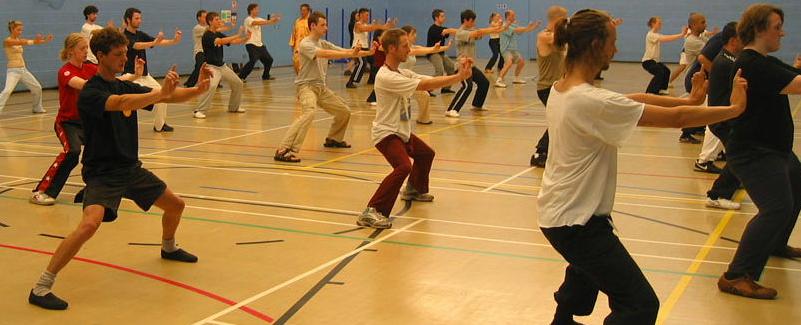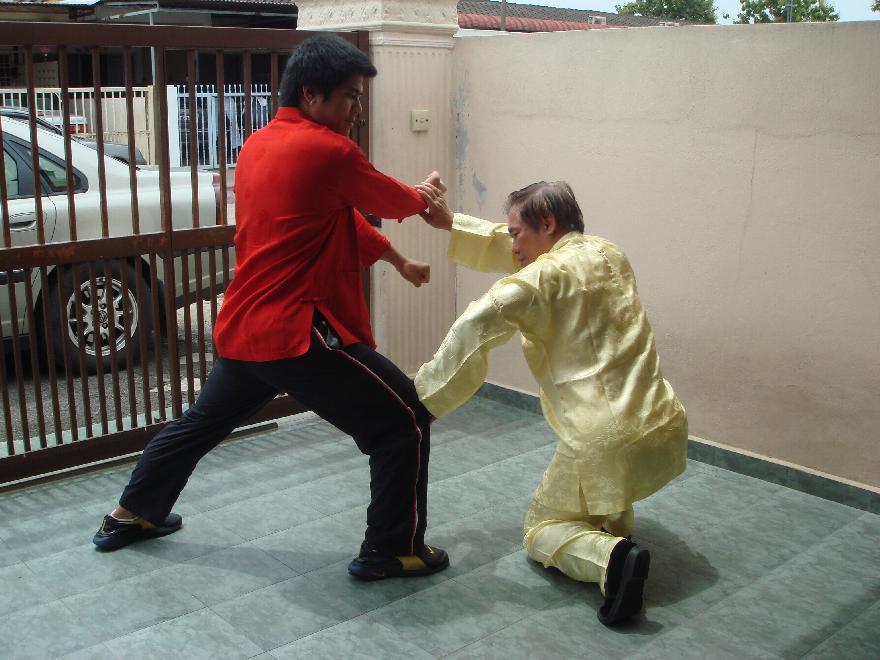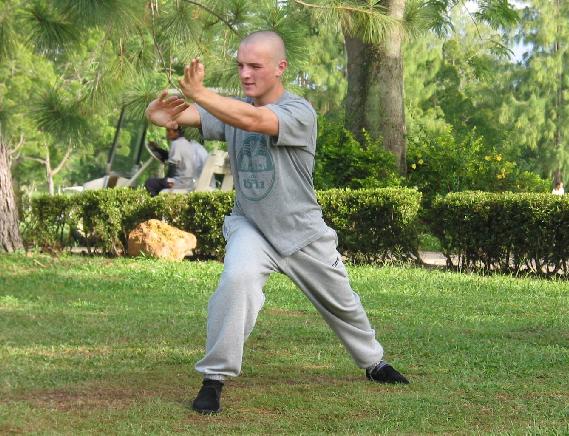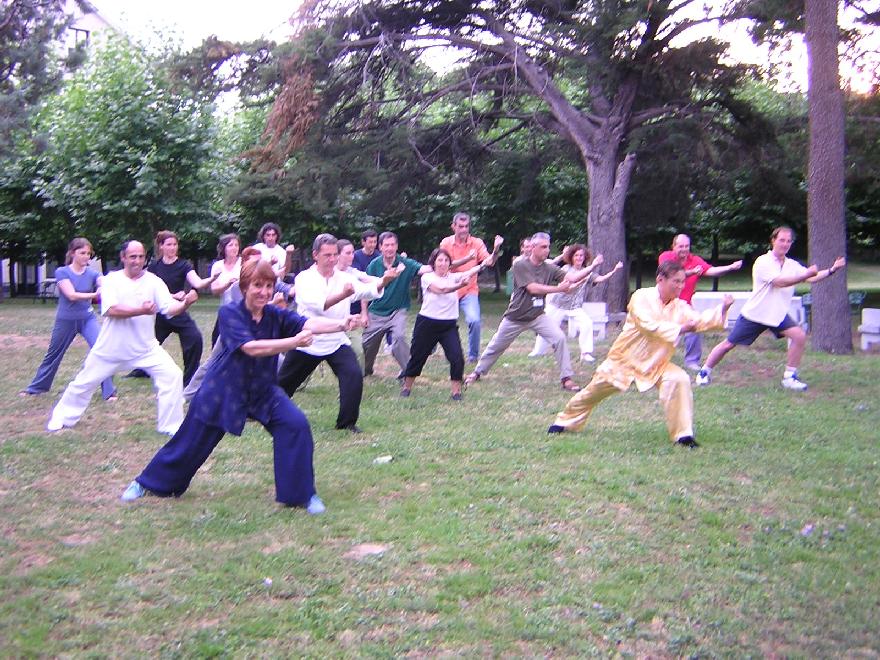February 2009 (Part 2)
SELECTION OF QUESTIONS AND ANSWERS

In our school we pay much attention to basic arts, like stance training. Here, participants at the Shaolin Kungfu course at the UK Summer Camp 2007 practiced the Golden Bridge.
Question 1
I have a specific question on specialized arts in Shaolin.
— Christian, USA
Answer
The term “specialized arts” may have different meanings to different people, or to the same people in different situations.
Generally, arts or “kung” (spelt “gong” in Romanized Chinese) may be classified as basic and specialized.
Basic arts are the most important. They determine to a great extent how far and how fast a student progress in his training. Examples of basic arts in Shaolin Kungfu are stance training, footwork, body-movement, breath control and explosion of force.
We pay much attention to these basic arts in our school, Shaolin Wahnam. In fact, in all the courses that I offer, which range from regional introductory courses to intensive advanced ourses, I go over all these basic arts in varying degrees of intensity depending on the type of courses, the time available as well as the developmental stage of the course participants.
Many other schools, however, pay little or no attention to these basic arts. Some instructors, for example, consider stance training a waste of time, and many students do not know how to move effectively, resulting in sustaining knee injuries and back pain.
When students have attained a reasonable level in the basic arts, they choose specific arts for specialization. Traditionally there are seventy two specialized arts in Shaolin Kungfu, such as Iron Palm, Golden Bell, Continuous Kicks, Chin-Na (special ways of gripping), Art of Lightness and One-Finger Zen.
Besides special skills or “kung”, specialized arts may also refer to particular kungfu sets that advanced students specialize in, in contrast to basic sets that all students practice, especially at the elementary levels.
One must not be mistaken that basic sets are less important or less useful. In fact, like basic skills, basic sets are most important and useful as they lay the foundation upon which advanced sets are based and their techniques are widely used in combat.
In our school the basic Shaolin sets are “Lohan Asks the Way”, “Black Tiger Steals Heart”, “Fierce Tiger Speeds through Valley”, “Happy Bird Hops up Branch”, “Fell Tree with Roots” and “Cross-Roads at Four Gates”. Our specialized sets include “Shaolin Five Animals”, “Tiger-Crane”, “Dragon-Tiger”, “Dragon Form”, “Monkey Set” and “Shaolin Pakua”.
Question 2
I know about, and have heard of, many internal, hard, soft Shaolin skills and forces, etc, but I have not heard of any specialized force that is specifically developed through, or develops ability of shen.
Answer
The development through and ability of shen, or mind, is essential in all aspects of genuine, traditional Shaolin Kungfu, including its basic and specialized arts. This also applies to qi, or energy.
Genuine, traditional Shaolin Kungfu is not just a training of physical body; more significantly it is a training of mind and energy. Debased and low-level Shaolin Kungfu, however, only trains the physical, neglecting mind and energy, which is shen and qi.
In our school, when a student executes some physical movement, like performing a Shaolin pattern such as “Black Tiger Steals Heart”, he focuses his mind on and channels energy to his punch.
This involves his ability of shen as well as qi. Through consistent practice, his shen as well as qi develop, resulting in mental clarity and internal force, amongst other benefits. He may use this exercise as a specific technique to develop his shen and qi, or reversely he may apply his shen and qi to perform this pattern well.

Tiger-Claw is one of the specialized arts in Shaolin Kungfu. Grandmaster Wong applies the Tiger-Claw in a pattern known as “Hungry Tiger Returns to Den” on Sifu Wong Chun Nga.
Question 3
My question is this: do you know of any such skills or forces in traditional Shaolin training, or in any field or art, and if so, would you please name a few?
Answer
Yes, I know of such skills in Shaolin training as well as in many other arts like Taijiquan, painting, poetry composing, writing, public speaking, eating ice-cream, negotiating a contract, and dating a girl, to name just a few as they come to mind. My students and their students also also know of such skills, which they use to enrich their live and the lives of others.
In Shaolin Kungfu, for example, I can use the pattern “Pushing Mountain” to develop my shen and qi. As a result of my improved mind and energy, not only I am more efficient in combat, I am also more effective in healing others.
When I speak in public, my mental clarity enables me to see clearly the material I wish to present without having to refer to prepared notes, and my energy enables me to speak with force and conviction in a huge hall without the need of a microphone.
Question 4
It would be immensely appreciated, and I would consider it a great service for it would benefit my concept of the various Shaolin arts and their scope and range. As I progress in my training, I have had this issue on my mind, of sitting somewhere in deep recesses for some time.
Answer
Like most other students today, your problem is due to your perverted view of Shaolin philosophy and practice. If you think of and practice Shaolin Kungfu as some external martial art where you have to tense your muscles and grimace your face, you are unlikely to develop your mind or your energy. In fact, your training would make your shen and qi worse, resulting in you being agitated and blocked. Even sitting somewhere in deep recesses would not improve your shen.
You may then look for some specific methods to develop your shen, imagining that these methods are different and apart from your physical Shaolin movements like performing patterns and sets. You will be surprised as well as confused when told the truth that every movement in genuine, traditioanl Shaolin Kungfu is a training of shen and qi.
In other words, irrespective of whether a student of genuine, traditional Shaolin Kungfu practices his Horse-Riding Stance, performs a kungfu set, or engages in sparring, he will improve his shen and qi. Without practicing other exercises but just training his genuine, traditional Shaolin Kungfu he will have more mental clarity and internal force, besides other benefits.
Nevertheless, I shall describe a simple exercise for you to improve your shen. Hang a sandbag, which must not be too big or heavy that striking it causes you discomfort. Sit at a Horse-Riding Stance or Bow-Arrow Stance and hit the sandbag alternatively with your right and left punches 30 times (counting a right punch and a left punch as two times).
You must not tense any muscles as you punch, nor grimace your face. For each hit, gently be aware of how your punch lands on the sandbag, and how it moves as a result of your punch. Please take note of the instruction that you should be gently aware. If you force yourself to be aware, or think of how your punch lands, or speculate on how the sandbag moves, you are not following the instruction, and this may cause harm.
After punching the sandbag, bring your feet together and stand upright with your arms hanging loosely at your sides. Be totally relaxed. Don't think of any thing. Just enjoy the stillness for about 5 minutes, then conclude the session.
Gradually increase the number of hits on the sandbag to 300 times, or any number you find suitable. If you practice this daily for six months, you will be amazed at how much you have improved you shen, or mind. But if you work yourself into a frenzy and hit the sandbag brutally with tensed muscle and grimaced face, your shen will become dull and your qi blocked.

In our school, every movement in Shaolin Kungfu is a training of zhen, or mind. The presence of mind is obvious in this performance of the Shaolin pattern “Sharp Knife Trims Bamboo” in our basic kungfu set “Cross-Roads at Four Gates”.
Question 5
Do you teach a fast form?
— Miguel, Ecuador
Answer
I do not know what you mean by “a fast form”.
All our forms can be perfomed slowly or fast. Sometimes the forms can be so fast that you may not be able to see them properly.
Question 6
Who created the fast form?
Answer
Perhaps you were refering to the Taijquan Fast Form created by Sifu Tong Yin Kit in the 1950s.
But before this time Taijiquan was performed fast by past practitioners, especially during combat, though they performed it slowly when learning it.
However, since the 1900s Taijiquan has been debased from an internal martial art to an external health exercise. It was performed slowly to such an extent that many people mistakenly thought that it should not be performed fast!
Frustrated by such a ridiculous situation, Sifu Tong Yin Kit who maintained that Taijiquan was a martial art, created a Taijiquan Fast Form.
Question 7
Was the fast form modified? By whom?
Answer
The original fast Taijiquan, which was Chen Style Taijiquan, was modified by Sifu Yang Deng Fu. Sifu Yang Deng Fu, who himself was a great fighter, modified the smaller and fast movements of Taijiquan for combat into bigger and slow movements for health purporses. This style of Taijiquan came to be called Yang Style Taijiquan.
Interestingly, Sifu Yang Deng Fu's disciple, Sifu Tong Yin Kit who also had learnt from other masters previously, modified the slow Taijiquan form into a Taijiquan Fast Form.

We do not need a fast set in Wahnam Taijiquan because every movement can be performed slowly, fast or in normal speed. Here Grandmaster Wong leads a Taijiquan class in Spain performing the Taijiquan pattern “Cannon Towards Sky” in fast speed.
Question 8
When do you teach the fast form? At the beginning or only to advanced students?
Answer
Your question does not apply to our school. We do not need to have a fast form because our students can perform any of our forms at normal speed, slowly or fast.
Question 9
Is there any school in Central, FL affiliated to you? If not, do you have any distance learning program available, like DVDs to learn from and then go to any seminar? I know this is not the best way, but would be an option?
Answer
One of our best instructors, Sifu Anthony Korahais, is teaching in Florida. His contact particulars are as follows.
Tel: 352-672-7613
E-mail:
http://flowingzen.com/contact.htm
Website:
http://www.flowingzen.com
Question 10
Also, I would like to suggest to you to organize your Question and Answer section by subjects.
Answer
Thank you for your suggestion. Please refer to our Question-Answer Index .
LINKS
Selected Reading
- Is Wushu the Same as Kungfu
- Taijiquan Sparring
- Seeing Things Clearly and in a Completely Different Way
- Application of Wing Choon Folding Arms
- The Use of Internal Force
